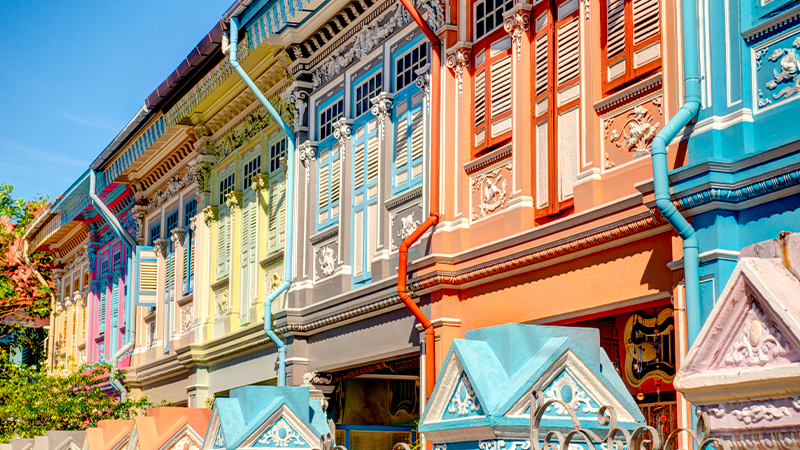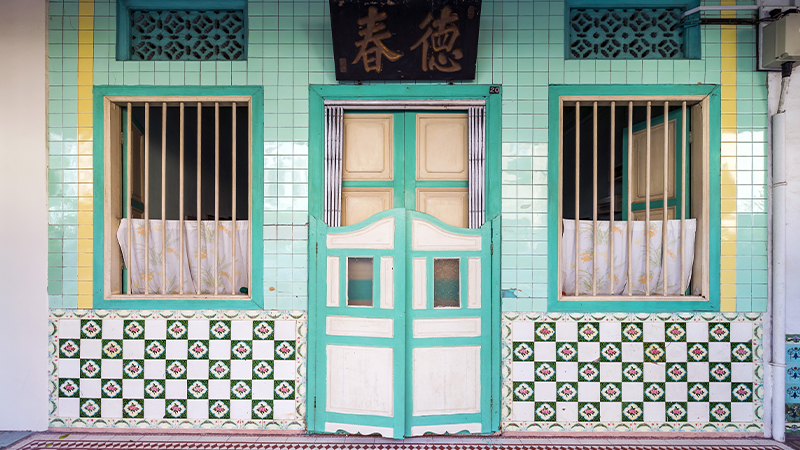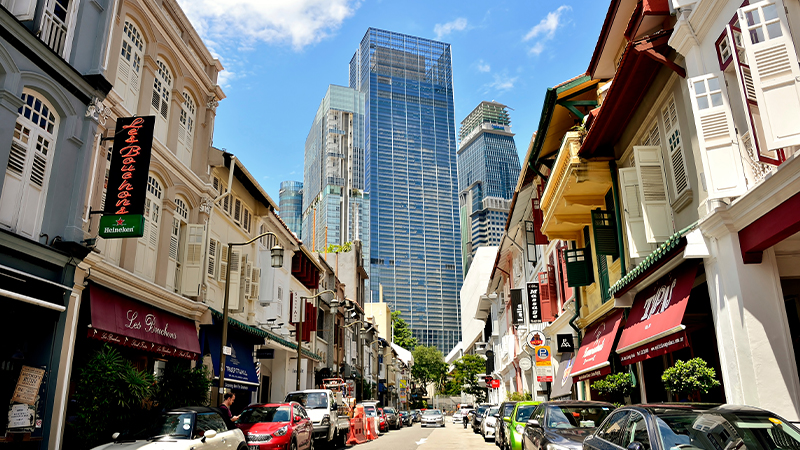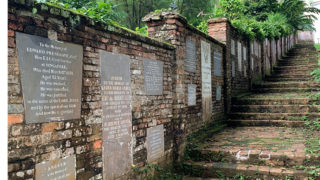We love Singapore’s shophouses! They’re a striking and beautiful example of Singaporean architecture – and a treat to stroll past in the various neighbourhoods where they can be found across the island. Here, we take a look at the history of shophouses in Singapore, and the Peranakans who influenced their style and structure.

The Singapore shophouse in history – from the 1800s onwards
Shophouses developed in Singapore in the wake of various town-planning instructions issued by Sir Stamford Raffles in the 1820s. Raffles had dictated that each house should provide a verandah at the front; together, these formed a continuous and covered passage from dwelling to dwelling, along both sides of each street.
The arcades or colonnades that formed as a result were ideal for conducting retail activities at ground level. Families and owners who operated businesses in this way would then shift their living quarters to a second storey or higher. The word “shophouse” derives from this dual purpose.
Shophouse architecture can trace its origins back to China – especially southern provinces such as Guangdong and Fujian, where many of Singapore’s early immigrants came from. And it’s the descendants of these early Chinese settlers – the Peranakans (or Straits Chinese) – who are most commonly associated with the shophouse style we know today.
Peranakan culture has a unique cuisine, dress, and marriage and other social rituals; it’s a fascinating blend of Chinese and Malay heritage. Many Peranakans were also influenced by their Dutch and then British colonisers, and this played a part in the development of the unique ornamentation they brought to the shophouse.
Distinctive features of shophouses
Shophouses in Singapore have two or more storeys, reflecting the dual commercial and private purpose we mentioned earlier. The structure is not free-standing but rather connected to several other shophouses in a row. Some shophouses also have a “five-foot way” (kaki lima) or covered walkway at the entrance – the same passageway introduced by Raffles in the 1820s.
Shophouse architecture is well known for its use of spectacular ornamentation; this includes coloured ceramic tiles, and features like pendants, columns, festoons, plaques and arabesques. You can also find highly crafted Malay-style fretwork fascia boards and balustrades, glazed ceramic blocks and Chinese panel frescos.

The different styles of shophouses in Singapore
Over the course of the history of shophouses, distinct styles of architecture emerged, reflecting different periods. Here are some of those.
Early Shophouses of the 18th Century
These have the front façade with a continuous row of panelled or louvered shutters, timber walls and plain masonry pilasters on the upper floor.
Traditional Shophouses of the 19th Century
Here, the front walls were made of masonry, which best was known for its use of spectacular ornamentation. The louvered shutters also remained, with either iron or timber grilles inserted in the windows.
Straits Eclectic Shophouses
Built between 1900 and 1940, this style of shophouse is mainly associated with Peranakan heritage. The elegant interiors of these shophouses were sumptuously furnished with specially chosen antique Chinese furniture, often inlaid with mother-of-pearl, and decorated with exquisite porcelain ornaments and distinctively colourful Nyonya crockery.
Art Deco Shophouses
Built from the 1940s into the 1960s, these buildings began to incorporate the design features of the day, including elements of Western arts and crafts and Art Deco movements.
7 things you might not know about Singapore shophouses
- Shophouses are bigger than they look! The small frontages of these terraced houses belie their size; they actually consist of a succession of single rooms extending back to a surprising depth.
- The front room was where the men of the house gathered; for a woman to spend time there would be seen as rather “forward”.
- The second room usually featured a sunken well, with the space above it open to the sky, providing light and ventilation. Nowadays, these have become fishponds or atriums. Depending on the depth of the house, there might be another well and skylight farther down.
- There was no glass in the windows of Singapore houses until 1927; even then, it was only used in smaller windows, often brightly coloured, for decorative purposes. Colonial architectural styles, including shophouses, relied on through-ventilation – glass windows make houses hot.
- Fire was always a risk. The British colonial government designed the wall that extends above the roofline to serve as a firebreak; they also imposed a compulsory alleyway at the back of the houses to provide another firebreak.
- The external spiral staircases built onto many of the houses were known as the “lover’s getaway”; they were a means of discreetly exiting the house for a secret rendezvous!
- Chinese families living in shophouses will typically display traditional plants outside the house. To keep bad luck away, there will be something sweet, something red, something fleshy and something thorny; a jasmine bush and a red-flowering cactus would do the trick.

Where to find shophouses in Singapore
Interested in the history of shophouses and the different architectural styles of properties in Singapore? Head to the following neighbourhoods to find the main clusters of shophouses on the island.
- Boat Quay
- Cairnhill
- Clarke Quay
- Emerald Hill
- Joo Chiat
- Keong Saik
- Little India
- Spottiswoode
Keen for more? Read our feature about the iconic black-and-white houses in Singapore; and find where to buy great furniture for your own home!
Don't miss out on the latest events, news and
competitions by signing up to our newsletter!
By signing up, you'll receive our weekly newsletter and offers which you can update or unsubscribe to anytime.



